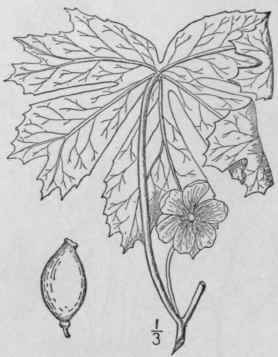6. Podophyllum L. Sp. Pl. 505. 1753
Description
This section is from the book "An Illustrated Flora Of The Northern United States, Canada And The British Possessions Vol2", by Nathaniel Lord Britton, Addison Brown. Also available from Amazon: An Illustrated Flora of the Northern United States, Canada and the British Possessions. 3 Volume Set..
6. Podophyllum L. Sp. Pl. 505. 1753
Erect perennial herbs, with horizontal poisonous rootstocks, large peltate palmately lobed leaves, and solitary white flowers. Sepals 6, petaloid, fugacious, the bud with 3 fugacious bractlets. Petals 6-9, flat, obovate, longer than the sepals. Stamens as many or twice as many as the petals; anthers linear, longitudinally dehiscent. Pistil 1 (rarely several); ovary ovoid, many-ovuled, forming a large fleshy berry in fruit. Seeds numerous, obovate, enclosed in fleshy arils. [Greek, Anapodophyllum, duck-foot-leaf.]
A genus of about 4 species, the following typical one native of eastern North America and Japan, the others Asiatic.

1. Podophyllum PeltÓtum L. May Apple. Wild Mandrake
Fig. 1961
Podophyllum peltatum L. Sp. Pl 505. 1753.
Erect, 1°-1 1/2° high. Basal leaves centrally peltate, nearly 1° in diameter, long-petioled, deeply 5-9-lobed, glabrous, or pubescent and light green on the lower surface, darker above; lobes 2-cleft and dentate at the apex; flowering stems appearing from different rootstocks, bearing 1-3 similar leaves, or occasionally leafless; flower white, stout-peduncled, nodding, 2 broad, appearing from the base of the upper leaf and generally from immediately between the two leaves; stamens twice as many as the petals; fruit ovoid, yellowish, 2' long, edible.
In low woods, western Quebec and throughout southern Ontario to Minnesota, Kansas, Florida, Louisiana and Texas. Ascends to 2500 ft. in Virginia. Indian- or hog-apple. Devil's-apples. Wild-or ground-lemon. Puck's-foot. Raccoon-berry. May.
Continue to:


